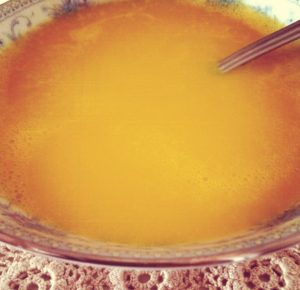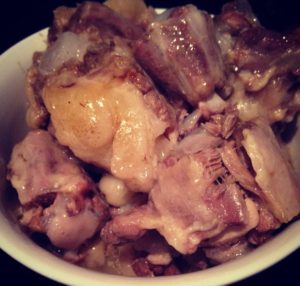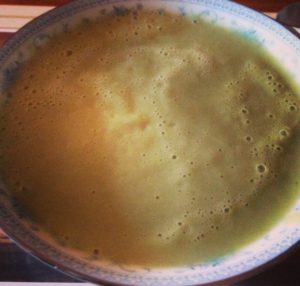Oh hello there. You’ve found some very old content. Please read the disclaimer on this page before thinking I’m still a total sheep who has been sucked into a bone-broth worshipping fad diet. Been there, learned from that and am now a much less rigid human.
I promised a GAPS diet protocol update and an peek into the routines and meals that make up the first stage. So here we are.
Stage 1 of the introduction diet is the most intensive part of the protocol that there is (in terms of restriction). It is the most gentle stage and really settles an inflamed gut before any new foods are introduced. Here’s what I was allowed to eat (according to Dr Natasha Campbell McBride’s book Gut and Psychology Syndrome);
- Meat stock and/or bone broth (homemade) and any fat, meat, connective tissue or marrow that came from the bones. The fats and gelatin in the broth are vital for the healing and sealing of the gut lining and broth should be had with every meal, either as a soup or in a mug on the side of the meat and veggies
- Vegetables, cooked very well in the broth (either blended all together to make a soup or drained and seasoned with salt and pepper, served with meat and connective tissue from the bones)
- Fermented foods; homemade 24-hour yoghurt, the whey from the homemade 24-hour yoghurt and the juice from sauerkraut. Adding a small amount to each bowl of soup and/or cup of stock and gradually increasing amount over time
This might not sound like a lot, but it was surprisingly easy to do. The hardest part was definitely preparation – but even that wasn’t too tricky. Doing GAPS you always needs to have stock, bones (for making stock), veggies and your ferments ready to go. Here are some of the routines that I got into to make life easier;
- Prepare bone broth (recipe below) in slow cooker the night before and cook whilst you sleep, you’ll wake up to an insanely delicious smelling kitchen and have a big pot of nourishing broth ready to use straight away
Bone Broth Recipe
You will need …
1 large beef marrow bone cut into fours, or a whole chicken carcass (plus saved roasting juices), or the bone from a roast (plus saved pan juices), or lamb knuckles, or ox tails or beef soup bones (basically some good quality meat bones that still have some meat and lots of fat still covering them)
Filtered water to cover the bones
Splash of Apple Cider Vinegar
Then all you do is; Put bones (I use mostly grass-fed beef marrow bones from the butcher – they still have connective tissue attached which is luscious and soothing) in the slow cooker with enough filtered water to cover bones and the Apple Cider Vinegar (optional, but preferable as the avidity draws the healing minerals out of the bones) and switch on before going to bed. In the morning you have broth ready to go for breakfast, lunch and dinner.
Notes
DO NOT SKIM THE FAT FROM THE TOP. Unless you’re making tallow (beef fat) to use for cooking or add back to soups. In this first stage pretty much all your energy is coming from healing broth fats. In later stages when you’re eating other fats; avocado, nuts, seeds, olive oil etc. you may find you want to skim the fat but in the first few stages the animals fats are an important aspect of your recovery. The more animals fats you can consume – to tolerance, you don’t want to consume it to the point of feeling sick. Listen to your body and trust that it knows what it needs – the better!
Other Handy Hints
- make more yoghurt (or sour cream) before you finish the previous batch. That way you’re never without it. It only takes about 15 minutes to prepare the yoghurt (but 24 hours to ferment it). So I’d find 15 minutes somewhere in my day to prepare it and then the next day I’d spend 5 minutes setting it up to drip (the process used to separate the curd from the whey – whey is superb in broth and veggie soups)
- Buy more vegetables while you still have enough. It’s easy to let stocks run low normally, but on GAPS you are relying on your soups as your number one source of nourishment. For example if I only had half a head of cauliflower left, I’d buy another two half a heads that day. If I only had one soups worth of pumpkin, I’d buy another half a butternut, etc. etc.
- Enjoy the simple food on Stage 1 (soups, broth, homemade yoghurt, soft gelatinous tissue etc. are really yummy) and start planning for the second stage – make sure you have organic eggs and some ghee (you can make ghee or find a good, organic source that you trust). This way you can start Stage 2 whenever you feel ready, you don’t have to wait until shopping day.
I stayed on Stage 1 for 14 days. I’m still not sick of soup . Miracle! I experienced only a few minor die-off symptoms such as mild fatigue and a few stomach aches with accompanying nausea (usually overnight and usually occurring after meals where I had eaten a lot of fatty connective tissue from meat bones. No sweats. It was short lived and subsided upon cleansing my bowels. TMI? Never.
My diet consisted of a large pot of soup (usually pumpkin) spread over the coarse of the day. I always added whey and/or yoghurt to the bowls and mugs of soup. If I was particularly hungry I might start to pick at the collection of connective, fatty meat tissue that I had sitting in the fridge ready for dinner. Dinner was veggies cooked in broth (drained and served as a drink on the side) seasoned and served with connective tissue stripped from meat bones.
It definitely helped that I basically followed a Full GAPS-style diet for a few months prior to starting the introduction diet. This was more by default really, I didn’t really know what GAPS was until December last year. Apart from the odd serving of rice or roasted spuds or sweet spuds, I was eating a GAPS-like spread.
I ate heaps of slow cooked meats, nourishing fats and fermented foods. This assisted with being able to introduce fermented foods from the very start of the introduction diet. I didn’t have any trouble with whey or yoghurt, (once on stage 4 my body started rejecting the yoghurt but I swapped it for sour cream and that worked much better … I think the dairy protein was too much …This is me updating this post nearly two years later by the way) even on the first few days and this probably accelerated the healing process.
By day 15 I felt ready to introduce raw egg yolks, which up until then hadn’t sounded appealing. They went down fine and filled me up enough that I didn’t have to eat four bowls of soup per meal time. I started making smaller portions of soup (two bowls worth) per meal, adding an egg yolk to one of the two bowls. My broths were now lasting longer. Less cooking. Yay.
Final Thoughts
The best thing you can do on GAPS is listen to your body. If you don’t feel ready to try a new food, there’s probably an innate reason as to why. If you are craving a food from a later stage, try a little and see how you go. GAPS is an individual journey and there are only guidelines not ‘rules’. The golden rules are 1) keep up the broths and 2) stay away from all processed and starchy foods.
There are heaps of stories you can read about on the internet about people with chronic die-off symptoms or severe reactions, to even the slightest amount of fiber. There are people that are constipated for weeks (TMI?) or up to there elbows in diarrhea every time they introduce a new food (poor souls). Remember that a lot of these people were very unwell to begin with, or went from the Standard Western Diet one day, to Gaps intro Stage 1 the next. If you already eat some GAPS meals and have a clean diet, then you probably won’t ever have to go through anything too painful.
The book can seem daunting because when introducing foods you start with such minute amounts that it seems like it would take weeks to even build up to a tablespoon of any one thing. The book takes into account the worst possible case scenario for each patient. If you feel innately called to use more than a few teaspoons of sauerkraut juice in your soups after day one (especially if you were eating loads of actual sauerkraut before beginning the into diet) then you’ll probably be okay.
Relax and go as fast or as slow as you feel called to do. If you run into trouble, go back to just the soups and slow cooked meats for a few days to settle the gut before trying anything new. I definitely recommend easing yourself into Full GAPS before starting the intro diet. It just makes life easier and less overwhelming.
Hopefully this post has been insightful regardless of whether you are following GAPS, thinking about doing GAPS, or otherwise.




